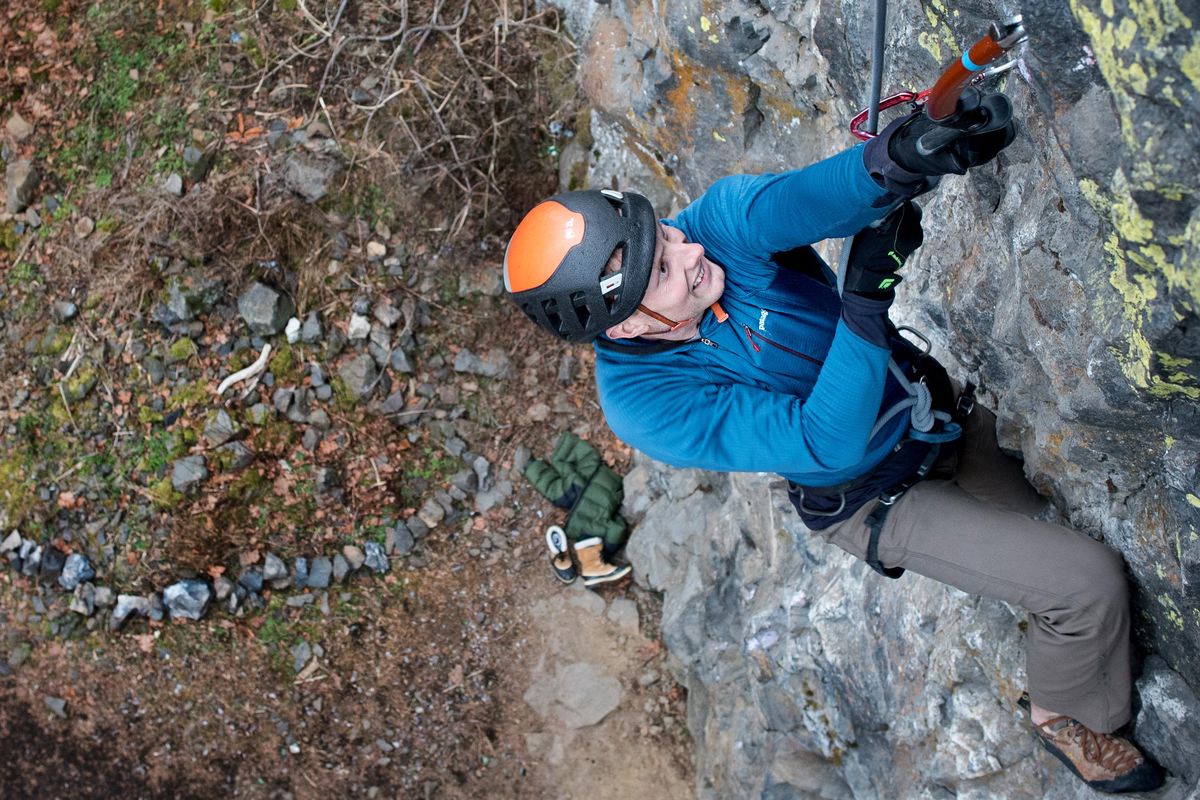Dry tooling, a subdiscipline of climbing, brings climbers to Lincoln Park in all weather

Metal scratching rock. It’s an unnerving feeling.
Catching the sharp point of my ice axe onto a nubbin of rock, I trusted most of my body weight to this curved metal shaft. If it popped – which is not uncommon – all the stored energy will release in a kinetic explosion aimed, more or less, at my face.
While my forearms are tired, my hands, desperately grasping the handles of the ice tools, are screaming toward failure. I grip harder which, ironically, makes it more likely that the axe will pop.
“Basically, you’re climbing with two knives in your hand,” said one of my climbing partners, Kyle Breeding, succinctly summing up my anxieties about the entire endeavor.
It’s a Tuesday afternoon in early December and Breeding, me and Marlin Thorman are climbing at Lincoln Park on Spokane’s South Hill. In ways the type of climbing, known as dry tooling, is completely different than rock climbing. For instance, the climber is always gripping the handle of the ice tool, instead of the variety of holds and positions offered in rock climbing. Instead of feeling the rock with your fingers, you’re sussing it out with a hunk of sharpened metal.
But, in other ways it offers the same sort of enjoyment found in rock climbing. There is the physicality of it, the necessity of precise footwork and the fun of climbing up rock outside.

Like most climbing disciplines, dry tooling has evolved as a way of training for climbing mountains. Using ice tools on rock helps climbers become better ice climbers. Plus, on long alpine climbs, it’s not uncommon for climbers to be faced with rock sections (versus snow or ice). Knowing how to climb through those sections is invaluable.
That was why, about five years ago, Scott Coldiron and Jeff Zickler started dry tooling at Lincoln Park.
“We don’t have every day ice climbing that you can get to,” Coldiron said. “There was just no good way to train for that. Steep rock is a really efficient way to train for big alpine (climbs).”
For serious alpine climbers like Coldiron, Zickler and the late Jess Roskelley, that kind of training is invaluable.
For instance, last year Roskelley and Coldiron climbed a 2,600-foot gully in Montana on A Peak above Granite Lake. The climb, which earned both men recognition in one of the world’s most prestigious climbing awards, featured a “huge roof” that could only be surmounted by employing the same dry tooling techniques used at Lincoln Park.
A need for that kind of practice is what sent Coldiron and Zickler to Lincoln Park. They placed bolts in the rock wall and put anchors on top. The duo made sure to check with other area climbers before bolting. Dry tooling can be controversial. Over time ice axes (not to mention crampons) can chip and break rock, and dry tooling is mostly discouraged from areas that are already being used by rock climbers.
As it was, the Lincoln Park cliffs were not an established climbing area and weren’t high on the list for rock climbers. The rock is fragmented and overhung, a combination most climbers avoid.
For the first few years there were only a handful of people who would go there, mostly serious alpine climbers.
But, it has grown in popularity as the entire sport of climbing has infected mainstream consciousness.
“There are a lot of people who just getting into ice climbing,” Coldiron said. “There are some people who have never ice climbed and are just looking for something fun to do.”
Most Wednesday nights starting at 5:30 p.m. a group of climbers meet at the cliff. For years the number of attendees hovered around a handful. Now it’s not uncommon for 10 or more to show up.
Coldiron attributes that to the growth of gym climbing. More and more people are learning to climb in the safe, indoor setting that gyms provide. From there some head outside, eventually that overall increase in numbers trickles down (or up, if you will) to more obscure subdisciplines of climbing like dry tooling.
While some climbers complain about the increased interest, Coldiron embraces it.
Prior to climbing gyms the sport was largely reserved for the elites. The earliest American climbers, for instance, were members of Ivy League college climbing clubs. Since the advent of gyms, starting mostly in the 1990s, the sport has been “democratized,” Coldiron said, echoing the perspective of the legendary alpine climber Jim Donini.
“I love having new people out,” he said.
Megan Kirley, who is a physical therapist in Spokane, has been dry tooling at Lincoln Park for the past several months. For Kirley, dry tooling isn’t about training for ice climbing or for alpine climbing.
Instead it’s a way to climb outside all year. Because the cliff is overhung, and because you can wear gloves while doing it, dry tooling at Lincoln Park is done all year, rain, snow or cold.
“It’s great for climbing in the rain and training,” she said. “It’s good for training overall endurance in the off season.”
I’d have to agree with that. After just two laps up the wall my hands were perma-gripped and my arms were achy.
While the ice tools popped off, once, nothing bad happened. My face remains intact and, as always, the joy of being outside regardless of the weather, masked any residual fear.